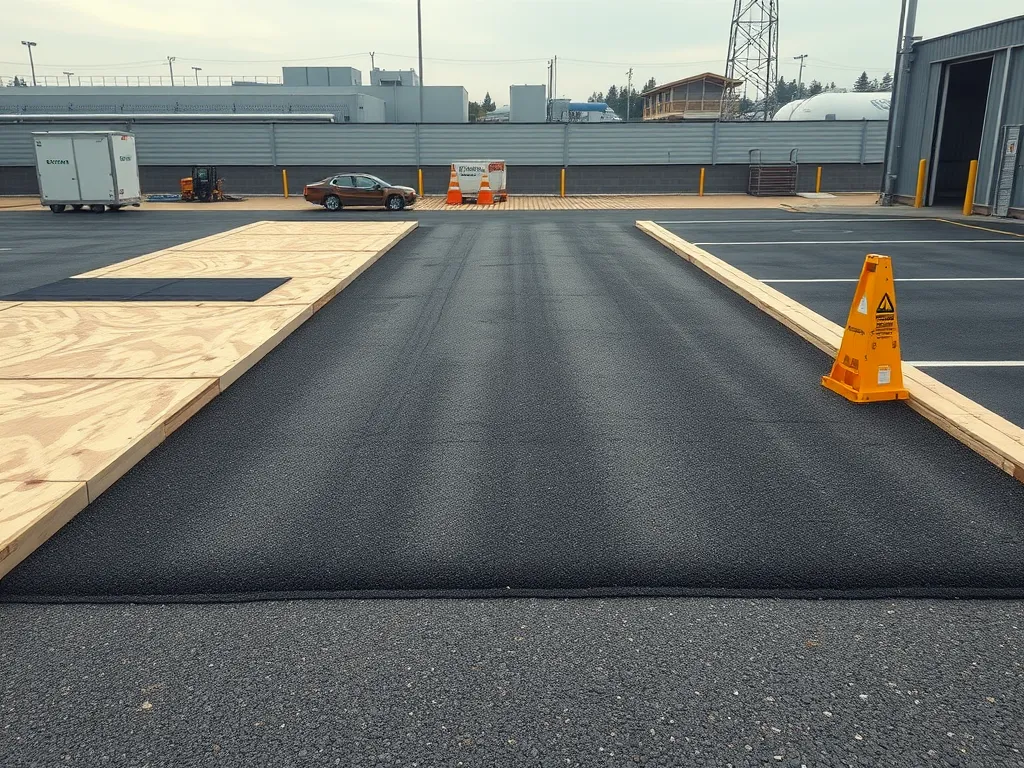Can You Drive on Fresh Asphalt Roads?
Published on: October 4, 2025 | Last Updated: April 14, 2025
Written By: George Voss
No, you shouldn’t drive on fresh asphalt roads until they’ve fully cured. Fresh asphalt needs 24-72 hours to harden before handling vehicle traffic. Driving too soon leaves tire marks, weakens the surface, and creates safety risks. Even light vehicles like cars can dent or shift uncured asphalt. Heavy trucks require longer wait times – up to seven days in some cases.
This article explains when and how to use fresh asphalt roads safely. You’ll learn curing timelines, weight limits for new pavement, and ways to prevent tire damage. We’ll cover maintenance tips, environmental impacts, and answers to common questions like “Can trucks drive on fresh asphalt?” or “Will tire marks disappear?”
Contents
- How Long Should You Let Asphalt Cure Before Driving?
- Can You Drive Over Freshly Paved Asphalt?
- Will Tire Marks on New Asphalt Go Away?
- Can Fresh Asphalt Damage Tires?
- How Long Before Driving on Freshly Sealed Asphalt?
- Walking on Fresh Asphalt: Guidelines
- Maintenance Tips for Fresh Asphalt Roads
- Environmental Impact Of Driving on Fresh Asphalt
- FAQs About Fresh Asphalt Roads
- Final Words
- Additional Resources for You:
How Long Should You Let Asphalt Cure Before Driving?
Wait 24-72 hours for cars. Heavy trucks need 7 days. But these times shift based on weather, mix type, and road use. Let’s break down why.
The Asphalt Curing Process
Fresh asphalt starts as a hot mix of rocks, sand, and sticky bitumen. As it cools, the bitumen thickens and binds the mix. Initial set happens in 1-3 days—enough for light cars. Full cure takes 6-12 months but isn’t needed for driving. The key? Let the surface harden to 300-400 psi strength before any traffic.
Factors Influencing Curing Time
Four elements change wait times:
| Factor | Impact | Time Shift |
|---|---|---|
| Heat | 70°F = 24h cure50°F = 72h cure | +/- 2 days |
| Thickness | 2-inch layer = 24h4-inch layer = 48h | Double depth = 2x time |
| Traffic | Cars: 1 dayTrucks: 7 days | 10k lbs adds 5 days |
| Sealants | Adds 4h drying | Total time +12h |
Rain or high humidity? Add 8-12 hours. Night temps below 40°F? Delay driving by 1-2 days.
Next, we’ll explore what happens if you drive too soon—and why tire marks might become permanent.
Can You Drive Over Freshly Paved Asphalt?
Freshly paved roads tempt drivers with smooth surfaces, but rushing onto them risks costly damage. Let’s break down why timing matters.
Immediate Risks Of Driving on Fresh Asphalt
Newly laid asphalt stays soft until fully cooled. Tire contact before curing leaves grooves or shifts the mix of bitumen (the sticky binder) and aggregates. Surface temps often exceed 140°F during placement—hot enough to soften rubber tires, increasing wear. Turning wheels while parked can tear the top layer, creating permanent ruts needing repairs costing $3–$5 per square foot.
Weight Limits for Fresh Asphalt Roads
Load capacity depends on curing progress. Most pavements need 24–72 hours before bearing traffic. The table below shows typical restrictions:
| Vehicle Type | Weight Range | Minimum Wait Time |
|---|---|---|
| Passenger cars | 2,000–4,500 lbs | 24–48 hours |
| Delivery vans | 6,000–10,000 lbs | 48–72 hours |
| Heavy trucks | 15,000+ lbs | 72+ hours |
Projects using PG 64-22 binders (common in warmer climates) might require longer wait times due to slower curing. Contractors often use cones or barriers to enforce these limits. Ignoring them can void warranties or trigger fines up to $1,500 in some municipalities.
While weight limits help protect new surfaces, tire marks pose another challenge. Let’s explore how they form—and whether they disappear.

Will Tire Marks on New Asphalt Go Away?
Tire marks on fresh asphalt often alarm drivers. The good news: most superficial marks fade as the pavement fully cures. Deeper grooves or ruts may need professional repair. Success depends on three factors: surface temperature, vehicle weight, and timing of the drive.
Causes Of Tire Marks on Fresh Asphalt
Fresh asphalt remains pliable for 48-72 hours after placement. During this phase, the bitumen binder hasn’t fully bonded with aggregates. Common causes of tire marks include:
- Soft surface: Asphalt stays malleable until cooled below 140°F (60°C)
- Sudden stops/turns: Lateral forces displace unset mix
- Heavy vehicles: Trucks exceeding 10,000 lbs GVWR leave deeper imprints
- Summer heat: Prolonged sun exposure slows hardening
Preventing Permanent Tire Damage
Follow these steps to avoid lasting marks when driving on freshly paved roads:
- Wait 72 hours before allowing vehicle access (96 hours in temps above 90°F)
- Restrict trucks/buses for 5-7 days post-installation
- Keep speeds under 15 mph during the first week
- Ban sharp turns or sudden braking on new surfaces
Contractors often use polymer-modified binders (PMBs) or warm-mix asphalt (WMA) to accelerate curing. These blends harden 30% faster than traditional hot-mix asphalt.
While tire marks pose one challenge, drivers also wonder how fresh asphalt affects their vehicles. Let’s examine the relationship between new pavement and tire wear.
Also See: Asphalt Durability Evaluation: Key Factors
Can Fresh Asphalt Damage Tires?
Fresh asphalt roads pose unique risks to tires. The mix of heat, soft surfaces, and tire rubber can lead to issues if driven too soon. Know the facts to protect your tires and road.
Impact Of Fresh Asphalt Heat on Tires
Hot mix asphalt hits 275-325°F when poured. Tire rubber softens at 200°F. Driving on fresh asphalt road while hot causes two problems:
- Tread sinks into soft asphalt, leaving marks
- Heat breaks down rubber, cutting tread life
Truck tires face higher risk due to weight. A 10-ton truck exerts 4x more force per tire than cars. This speeds mark formation on fresh asphalt.
Tire Types and Fresh Asphalt Compatibility
Not all tires react the same. Key factors:
- Summer tires: Softer rubber grips better but marks easier
- Winter tires: Harder rubber resists heat damage
- Load range: E-rated (heavy duty) tires handle fresh asphalt best
Radial tires (common in cars) show marks less than bias-ply (some trucks). Check tire specs before driving on new asphalt road.
Proper curing matters most. Once tires and fresh asphalt cool, focus shifts to surface coats. Next: how sealants change wait times.

How Long Before Driving on Freshly Sealed Asphalt?
Freshly sealed asphalt requires different handling than new pavement. While both need curing time, sealcoat applications demand shorter wait periods but stricter precautions.
Sealcoat Vs. Fresh Asphalt: Key Differences
Sealcoat (a protective layer of coal tar or asphalt emulsion) cures faster than fresh asphalt. New pavement uses hot mix asphalt (HMA) with aggregates and PG 64-22 binder heated to 300°F. Sealcoat sits atop existing asphalt at 50-70°F. This temperature gap creates varied curing needs.
| Feature | Sealcoat | Fresh Asphalt |
|---|---|---|
| Curing Start | Immediate drying | 24-hour cooling |
| Foot Traffic | 4-12 hours | 6-8 hours |
| Vehicle Traffic | 24-48 hours | 3-7 days |
Curing Time for Sealed Asphalt Surfaces
Most sealcoats need 24-48 hours before handling vehicle tires. Humidity below 50%? Cure time drops to 18 hours. Temperatures above 85°F? Wait 72 hours. Avoid driving on fresh blacktop seal during rain – water can wash away uncured emulsion, creating pockmarks.
Heavy trucks (over 10,000 lbs) should wait 72 hours minimum. Tire pressure matters too – vehicles above 35 PSI risk denting soft sealant. Test cured surfaces by pressing a coin into the coating. No indentation? Safe for use.
Up next: Learn how foot traffic affects fresh pavement differently than vehicles – and why sneaker soles matter more than you’d think.
Walking on Fresh Asphalt: Guidelines
Pedestrian activity affects asphalt curing just like vehicle traffic. While foot traffic poses less risk, timing and precautions matter for long-term pavement quality.
How Long After Paving Can You Walk on It?
Wait at least 6–12 hours before walking on fresh asphalt. Surface temperatures typically drop below 140°F within this window, allowing initial hardening. Cold weather (below 50°F) extends curing to 24+ hours. Thicker pavements (3+ inches) cure slower than thin layers. Always verify with your contractor—some mixes reach walkable status faster using polymer-modified binders.
Protecting Fresh Asphalt From Foot Traffic
Avoid high heels, pet claws, or sharp objects that dent soft surfaces. Use temporary walkways like plywood boards for frequent paths. Restrict bicycles, strollers, or wheeled equipment for 48 hours. Footprints deeper than 1/8 inch risk pulling bitumen binder from aggregates, creating weak zones prone to cracking under future vehicle loads.
Proper care during curing ensures your pavement stays intact when trucks and cars eventually use it. Next: Learn maintenance strategies for managing vehicle traffic on new asphalt.

Maintenance Tips for Fresh Asphalt Roads
Fresh asphalt requires careful handling during the curing phase to prevent costly damage. Follow these guidelines to protect your pavement investment.
Keep Distance Between Vehicles
Fresh asphalt remains soft for 24-72 hours after paving. Vehicles following too closely can leave tire impressions or surface deformations. Maintain at least 50 feet between cars during this period. This spacing allows heat to dissipate evenly and prevents concentrated pressure points.
Reduce Speed on New Surfaces
Speeds above 20 mph increase the risk of aggregate displacement on fresh pavement. Stick to 15-20 mph for the first 3-5 days. Lower speeds give the binder (PG 64-22 or similar) time to harden properly. Excess speed also raises the chance of leaving permanent tire marks.
Avoid Sudden Stops or Sharp Turns
Braking hard or turning sharply applies concentrated force to soft asphalt. These actions can create ruts or tear the surface layer. Use gradual stops and wide turns for the first week. Steering wheels should be turned no more than 45 degrees during this phase.
Limit Heavy Vehicle Traffic
Fresh asphalt roads can’t handle heavy loads until fully cured (typically 3-7 days). Keep vehicles under 10,000 lbs GVWR off the surface at first. Semi-trucks or loaded dump trucks exert up to 1,000 psi – enough to deform uncured pavement. Consider alternate routes for commercial vehicles during the curing window.
Proper care during the curing phase not only preserves pavement quality but also supports long-term environmental benefits.
Environmental Impact Of Driving on Fresh Asphalt
Fresh asphalt roads need care to last. Driving too soon harms both the road and the planet.
Emissions During Asphalt Curing
Hot asphalt gives off fumes called VOCs (volatile organic compounds) as it cools. These fumes rise when temps hit 300°F. Cars driving on fresh pavement trap heat, slowing the cure and keeping VOC levels high for hours. Light traffic adds 15-20% more emissions than waiting 24 hours. Warm days worsen this effect.
Sustainable Asphalt Maintenance Practices
Use recycled asphalt (RAP) for repairs. RAP cuts waste by 95% and lowers energy use by 20%. For new roads, warm-mix asphalt needs 50°F less heat, reducing fumes. Sealcoating every 3 years stops cracks, delaying full repaves. Avoid driving for 1-2 days post-seal to let eco-friendly coatings set.
Proper care balances road safety with green goals. Next, learn answers to common road-use questions.

FAQs About Fresh Asphalt Roads
How Long Can You Safely Drive on Fresh Asphalt?
It is recommended to wait at least 24-72 hours before driving on freshly laid asphalt, depending on the type of vehicle and environmental conditions. For heavy vehicles, a wait of 7 days or more may be necessary to ensure the asphalt has sufficiently cured.
Is It Acceptable to Drive on Restored Asphalt?
Yes, driving on restored asphalt is generally acceptable, but it’s important to follow the recommended curing times similar to those for new asphalt, which typically ranges from 24 hours up to several days, depending on the restoration methods used.
Can Trucks Drive on Fresh Asphalt?
No, trucks should generally not drive on fresh asphalt until sufficient curing time has passed, which can range from 72 hours to a week, as their weight can cause significant damage to the uncured surface.
Final Words
Driving on fresh asphalt requires caution. The new surface is delicate, and premature vehicle traffic can lead to permanent damage. Always adhere to recommended curing times, and avoid unnecessary weight on fresh asphalt to ensure longevity.
Remember to maintain a safe distance between vehicles, reduce speed, and avoid sudden maneuvers on new surfaces. Being mindful of these practices not only protects your investment but also contributes to better road performance down the line.
For more insights and precise calculations related to asphalt projects, check out Asphalt Calculator USA.
Additional Resources for You:
- National Asphalt Pavement Association (NAPA, Industry Reports & Best Practices)
- How Long Before We Can Drive On Fresh Asphalt & Sealcoating? Commercial Asphalt, Parking Lot Paving + Best in Pinellas! Anderson & Sons Asphalt of Pinellas
- ASPHALT DO’S & DONT’S – GW PAVING
- How long to wait to drive on new asphalt road? (tire, chip) – Automotive -Sports cars, sedans, coupes, SUVs, trucks, motorcycles, tickets, dealers, repairs, gasoline, drivers… – City-Data Forum
- City of Hudson Asphalt Road Resurfacing Frequently …


